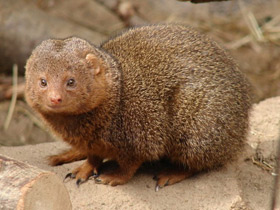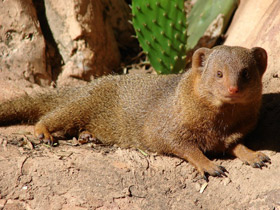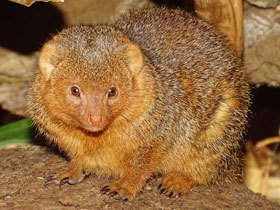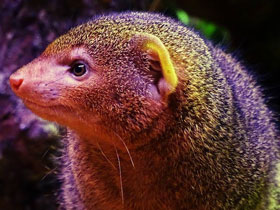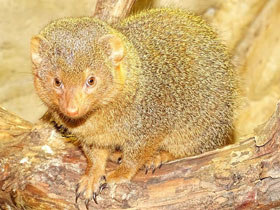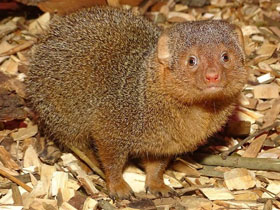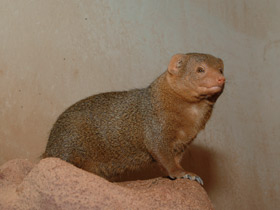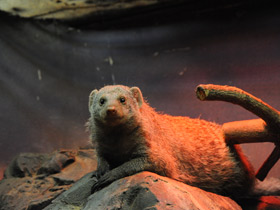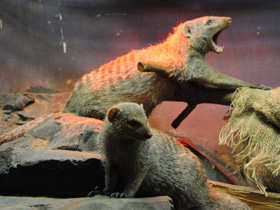The common dwarf mongoose (Helogale parvula)
Common dwarf mongoose видео
The common dwarf mongoose (Helogale parvula) is a mongoose species native to Angola, northern Namibia, KwaZulu-Natal in South Africa, Zambia and East Africa. It is part of the genus Helogale, along with the Ethiopian dwarf mongoose.
Appearance and habitat area
Helogale parvula is a small African carnivore of the family Herpestidae.
Helogale parvula is the most common small carnivore in southeastern and southern Africa. It is found in open wooded areas or wooded savannah, especially where there are termites, exposed rocks with crevices or hollow logs that can serve as shelter. Helogale parvula usually inhabits altitudes up to 2000 m above sea level, avoiding only very arid areas. The colour of its short, soft fur varies from yellowish to dark brown, and black can also be found.
Helogale parvula are the smallest of the family, measuring only 16-23 cm in length and 14-19 cm in tail; their weight varies between 210 and 420 g. Sexual dimorphism is not pronounced, with males and females differing little in size and coat colour. The body of Helogale parvula is very slender and elongated, allowing it to penetrate even the narrowest crevices. The claws are five-toed, short, moderately thick, with claws up to 10 mm long on the front claws and up to 8 mm long on the hind claws. The head of Helogale parvula is small, with a pointed snout and small, rounded, widely spaced ears.
Nutrition and lifestyle
This predator is almost entirely insectivorous, feeding mainly on beetles and termites, as well as millipedes, spiders, worms, molluscs and small vertebrates (rodents, birds and their eggs, lizards and snakes). Helogale parvula are active during the day and sleep at night in underground burrows, rock crevices and termite holes.
Social behaviour and reproduction
These animals live in groups of 9 to 12 (sometimes up to 30), with equal numbers of males and females. The group is led by the oldest female, with her mate in second place and her youngest offspring in third place. Usually only this pair breeds in the group, and all Helogale parvula offspring and pups are their offspring. Occasionally, when food is plentiful, subordinate females may also become pregnant, but their cubs rarely survive. Each group has its own territory, covering an area of about 2 hectares. In a day, Helogale parvula can walk about 1 km in search of food.
Breeding of Helogale parvula usually occurs during the rainy season, from November to March, but the dominant female sometimes manages to produce 3 pups per year. Pregnancy lasts between 49 and 56 days and the number of pups per litter ranges from 1 to 7 (usually between 4 and 6). They remain underground in the termite mound for the first two to three weeks. During the day, when adult Helogale parvula go hunting, one or more immature members of the group stay with the young as babysitters. Subordinate females sometimes even start producing milk (even if they have no cubs of their own) and feed the cubs to the dominant female. Later, all members of the group bring them food, play with them and also protect them from predators. In total, the cubs are cared for 45 days. Gradually, the adult Helogale parvula train them to get their own food and, after six months, they begin to feed with the group.
Females reach sexual maturity at one year of age, but do not produce young and do not leave their group. Young males usually separate from the group at 2-3 years of age. The life expectancy of Helogale parvula is 10 years for males and 14 years for females.
Subspecies
- Helogale parvula parvula;
- Helogale parvula ivori;
- Helogale parvula mimetra;
- Helogale parvula nero;
- Helogale parvula ruficeps;
- Helogale parvula undulatus;
- Helogale parvula varia.









